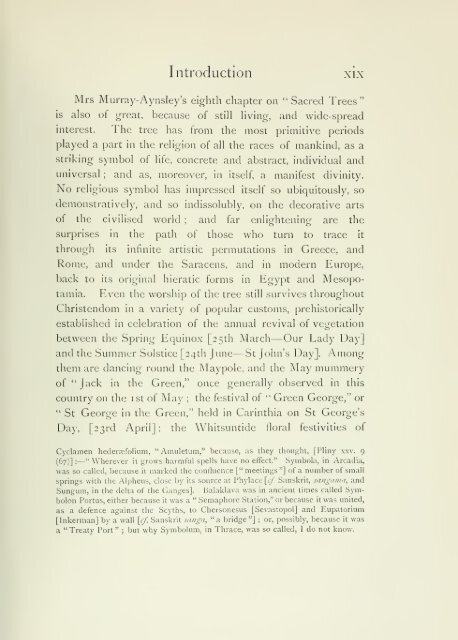Download Ebook - Free History Ebooks
Download Ebook - Free History Ebooks
Download Ebook - Free History Ebooks
You also want an ePaper? Increase the reach of your titles
YUMPU automatically turns print PDFs into web optimized ePapers that Google loves.
Introduction xlx<br />
Mrs Murray-Aynsley's eighth chapter on "Sacred Trees"<br />
is also of great, because of still living, and wide-spread<br />
interest. The tree has from the most primitive periods<br />
played a part in the religion of all the races of mankind, as a<br />
striking symbol of life, concrete and abstract, individual and<br />
universal ; and as, moreover, in itself, a manifest divinity.<br />
No religious symbol has impressed itself so ubiquitously, so<br />
demonstratively, and so indissolubly, on the decorative arts<br />
of the civilised world ; and<br />
far enlio-htenincr are the<br />
surprises in the path of those who turn to trace it<br />
through its infinite artistic permutations in Greece, and<br />
Rome, and under the Saracens, and in modern Europe,<br />
back to its original hieratic forms in Egypt and Mesopo-<br />
tamia. Even the worship of the tree still survives throughout<br />
Christendom in a variety of popular customs, prehistorically<br />
established in celebration of the annual revival of vegetation<br />
between the Spring Equinox [25th March—Our Lady Day]<br />
and the Summer Solstice [24th June—St John's Day]. Among<br />
them are dancing round the Maypole, and the May mummery<br />
of " Jack in the Green," once generally observed in this<br />
country on the ist of May ;<br />
the festival of " Green George," or<br />
" St George in the Green," held in Carinthia on St George's<br />
Day, [23rd April]; the Whitsuntide floral festivities of<br />
Cyclamen hederc-Efolium, " Amiiletum," because, as they thought, [PHny xxv. 9<br />
(67)] :— " Wherever it grows harmful spells have no effect." Symbola, in Arcadia,<br />
was so called, because it marked the confluence [" meetings "] of a number of small<br />
springs with the Alpheus, close by its source at Phylace \cf. Sanskrit, saiigama, and<br />
Sungum, in the delta of the Ganges]. Balaklava was in ancient times called Symbolon<br />
Portus, either because it was a " Semaphore Station," or because it was united,<br />
as a defence against the Scyths, to Chersonesus [Sevastopol] and Eupatorium<br />
[Inkerman] by a wall \cf. Sanskrit sanga, " a bridge "] ; or, possibly, because it was<br />
a " Treaty Port " ; but why Symbolum, in Thrace, was so called, I do not know.

















